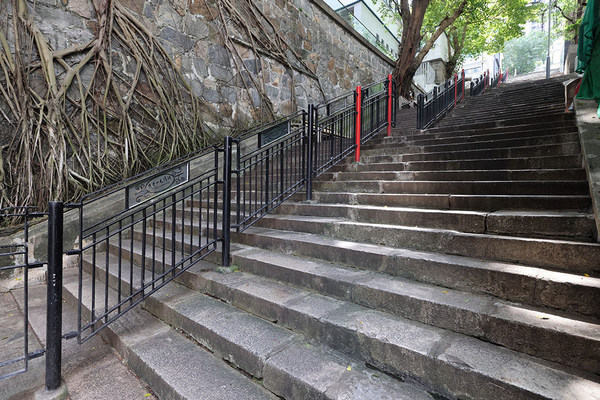Central School(Site of Former Queen's College)
Established in 1862 on Gough Street, Central School (also known as the Government Central School in The Hong Kong Government Gazette) was the first government school to provide Western education to Chinese boys in Hong Kong. In 1889, the school was relocated to the site at the junction of Aberdeen Street and Hollywood Road and was renamed Victoria College. In 1894, the school changed its name, once again, to Queen’s College.
In the school’s early years, renowned British educator Dr Frederick Stewart was appointed as headmaster. During his tenure, the school established equal emphasis on Chinese and Western knowledge. Students were required to study the Four Books and Five Classics, as well as, English and mathematics, resulting in the first group of elites who could master Chinese and English and served the country with their cross-cultural experience. Prior to the establishment of The University of Hong Kong, Queen’s College had a prestigious status and was hailed in Chinese as Da Shu Yuan or Da Shu Guan, meaning “Grand Academy” or “Grand College”.
During that time, Central School attracted many elite students from Hong Kong and the Mainland. Making use of their bilingual ability and cross-cultural experience, the graduates joined the railway, translation and newspaper industries, or foreign trading companies as compradors, thus contributing immensely to China’s modernisation. Among its graduates, many emerged as prominent figures in the late Qing revolutions, including Dr Sun Yat-sen and, a founding figure of the revolution, Liao Zhong-kai. Dr Sun Yat-sen enrolled in Central School in 1884 and is believed to have witnessed the foundation ceremony of the Hollywood Road campus. Liao Zhong-kai joined Tong Meng Hui (Chinese Revolutionary Alliance) in 1905 and followed Dr Sun in his revolutionary cause. Tse Tsan-tai, a graduate of the school, was the co-founder of the early revolutionary organisation Foo Yan Man Ser (Chinese Patriotic Mutual Improvement Association).
During the Japanese Invasion, some graduates of Queen’s College joined Hong Kong and Kowloon Brigade of the East River Guerrillas. Among them, Raymond Chok-mui Wong, graduate of 1935, was actively involved in the intelligence work of Dongjiang Column and British Army Aid Group. After the war, he was the only member of the Communist Party of China to be made a Member of the Order of the British Empire (MBE). In 1949, he took office as the second president of Xinhua News Agency (Hong Kong Branch).
The Hollywood Road campus was severely damaged during the Japanese Occupation. After the war, it was torn down to make room for the Police Married Quarters. Between 2005 and 2007, the Antiquities and Monuments Office conducted archaeological investigations at the site and unearthed the remains of the school’s foundation, which is now open to the public.
Opening Hours of Underground Interpretation Area:
Monday to Sunday:
7am-11pm
Enquiry Hotline: (852) 2870 2335
PMQ, No. 35 Aberdeen Street, Central,Hong Kong.

View of former Queen’s College from Hollywood Road, circa the late nineteenth century.©Hong Kong Museum of History

Foundation remains of the former Queen’s College, 2024.©Antiquities and Monuments Office

View of former Queen's College from Staunton Street, circa the late nineteenth century.©Hong Kong Museum of History

Granite staircases of former Queen’s College, 2008.©Antiquities and Monuments Office
-
扫一扫在手机打开当前页










